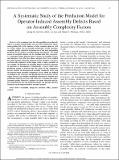A Systematic Study of the Prediction Model for Operator-Induced Assembly Defects Based on Assembly Complexity Factors
Author(s)
Lei, Liu; Qiang, Su; Whitney, Daniel E.
DownloadSu-2010-A Systematic Study o.pdf (1.750Mb)
PUBLISHER_POLICY
Publisher Policy
Article is made available in accordance with the publisher's policy and may be subject to US copyright law. Please refer to the publisher's site for terms of use.
Terms of use
Metadata
Show full item recordAbstract
It is a common view that the assembly process heavily affects a product's final quality and cost. The continuously shortening product life cycle requires a faster response speed as well as a lower defect rate in assembly production. In this situation, assembly quality control is becoming one of the most demanding problems in the modern manufacturing environment. The main causes of assembly defects can be classified into four categories, i.e., improper design, defective part, variance in assembly system, and operator error. The first three categories have been studied for many decades. However, elements of the operator error have not been fully explored. In this paper, using a copier assembly as an example, the problem of assembly defects caused by mistakes of operators is investigated systematically. A novel defect-rate prediction model is derived from the study of two complexity factors, namely, the design-based assembly complexity factor and the process-based assembly complexity factor, which are defined according to the structure and production characteristics of the copier. Several case studies consistently demonstrate that the new prediction model is accurate and stable for evaluating the copier assembly quality. Moreover, another case study offered in this paper demonstrates that the prediction model can provide effective assistance in the improvement of assembly quality.
Date issued
2009-12Department
Massachusetts Institute of Technology. Center for Technology, Policy, and Industrial DevelopmentJournal
IEEE Transactions on Systems, Man and Cybernetics, Part A: Systems and Humans
Publisher
Institute of Electrical and Electronics Engineers
Citation
Qiang Su, Lei Liu, and Daniel E. Whitney. “A Systematic Study of the Prediction Model for Operator-Induced Assembly Defects Based on Assembly Complexity Factors.” Systems, Man and Cybernetics, Part A: Systems and Humans, IEEE Transactions on 40.1 (2010): 107-120. © 2009 Institute of Electrical and Electronics Engineers.
Version: Final published version
Other identifiers
INSPEC Accession Number: 11020114
ISSN
1083-4427
Keywords
quality control, design for assembly (DFA), assembly